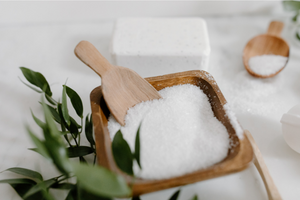Salt has been a part of our diet for thousands of years, but in recent years, we've seen an epidemic of hypertension or high blood pressure related to overconsumption of salt. This condition used to be something only older adults had to worry about, but now, even people in their 20s and 30s are being diagnosed with it. Why is this happening?
The answer is simple: we consume too much salt. On average, Americans consume about 3,400 mg of sodium or about 1 ½ teaspoon of salt per day. This is over fifty percent more than what our parents ate, and multiple times higher than what our ancestors consumed. The reason for this is the rise of processed fast food and pre-prepared meals in the grocery store. Salt is not only used as a flavor enhancer but also as a preservative and texturizer in processed foods.
Reducing your sodium intake can have a significant impact on your health, especially when it comes to blood pressure. The Dietary Guidelines for Americans recommend adults limit sodium intake to less than 2,300 mg per day. For children under age 14, recommended limits are even lower.
Here are some tips to reduce your sodium intake:
Cut Back on Processed Foods
Processed foods are the primary source of sodium in our diet. From packaged snacks to pre-prepared meals, processed foods contain lots of salt. When grocery shopping, look for whole foods or minimally processed products made with simple whole-food ingredients. This will significantly reduce your sodium intake.
Cook at Home
Cooking at home allows you to control the amount of salt in your food. Instead of using salt as a flavor enhancer, try using other herbs and spices. You can also reduce the amount of salt in a recipe by half or more without compromising taste.
Choose High-Quality Salt
When using salt to flavor your food, opt for high-quality salt. Himalayan pink or Celtic (gray) sea salt is the highest in trace minerals, which can help balance fluids, avoid dehydration, balance blood sugar, promote a healthy pH balance in the cells, and provide electrolytes critical for the proper function of muscle, nervous system, and brain function.
Increase Your Potassium Intake
Eating more potassium-rich vegetables and fruits can help balance sodium intake. Potassium helps reduce the negative effects of sodium on blood pressure. Fruits and vegetables like bananas, spinach, sweet potatoes, and tomatoes are excellent sources of potassium.
Essential Spices for More Flavorful Cooking

- Cinnamon.
- Garlic Powder.
- Turmeric.
- Chili Powder.
- Italian Seasoning.
- Cumin.
- Cayenne.
- Smoked Paprika.
- Ginger. Ginger, or ginger root, comes from the plant Zingiberofficinale, and is in the same family as cardamom and turmeric.
- Cardamom.
- Chili Peppers.
- Caraway.
Some common Herbs to use to flavor your food

- Basil.
- Bay leaf. Bay leaf provides a 'woodsy' flavor to sauces, stews, vegetables and grilled meats.
- Cilantro.
- Dill.
- Lemongrass.
- Marjoram.
- Oregano.
- Parsley.

0 comments